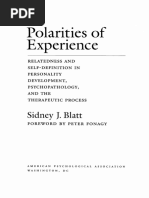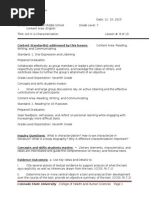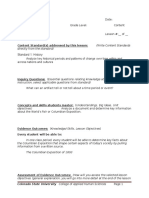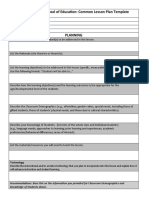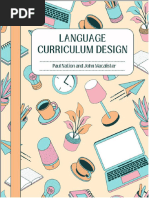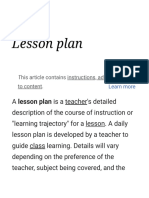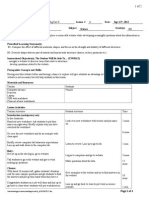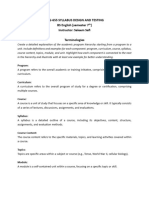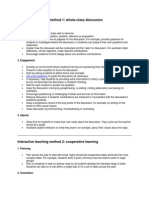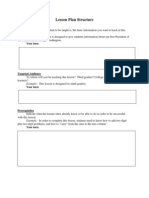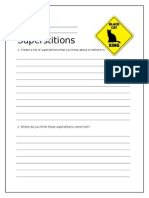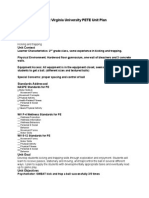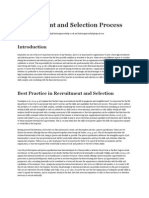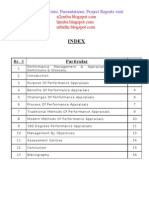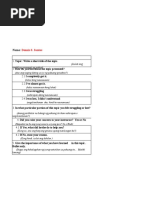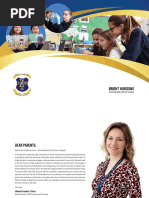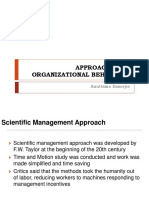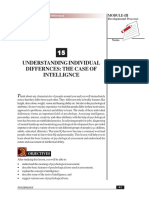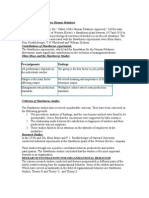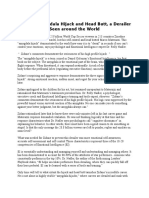CEP Lesson Plan Form: Colorado State University College of Health and Human Sciences Page 1
CEP Lesson Plan Form: Colorado State University College of Health and Human Sciences Page 1
Uploaded by
api-277220385Copyright:
Available Formats
CEP Lesson Plan Form: Colorado State University College of Health and Human Sciences Page 1
CEP Lesson Plan Form: Colorado State University College of Health and Human Sciences Page 1
Uploaded by
api-277220385Original Title
Copyright
Available Formats
Share this document
Did you find this document useful?
Is this content inappropriate?
Copyright:
Available Formats
CEP Lesson Plan Form: Colorado State University College of Health and Human Sciences Page 1
CEP Lesson Plan Form: Colorado State University College of Health and Human Sciences Page 1
Uploaded by
api-277220385Copyright:
Available Formats
CEP Lesson Plan Form
Teacher: Ms. Myers
11. 2015
School:
Blevins Middle School
Content Area: English
Date: 12.
Grade Level: 7
Title: Act 4 & Theme
of 10
Content Standard(s) addressed by this lesson:
Writing, and Communicating
Lesson #: 9
Content Area: Reading,
Standard: 2. Reading for All Purposes
Prepared Graduates:
Seek feedback, self-assess, and reflect on personal learning while engaging with
increasingly more difficult texts
Grade Level Expectation: Seventh Grade
Inquiry Questions: What is theme? What are some common themes in literature?
What themes do Macbeth and Mythology share?
Concepts and skills students master: Literary elements, characteristics, and
ideas are interrelated and guide the comprehension of literary and fictional texts
Evidence Outcomes: a. Use Key Ideas and Details to:
i.
Cite several pieces of textual evidence to support analysis of what the text
says explicitly as well as inferences drawn from the text. (CCSS: RI.7.1)
ii.
Determine two or more central ideas in a text and analyze their development
over the course of the text; provide an objective summary of the text. (CCSS: RI.7.2)
iii.
Analyze the interactions between individuals, events, and ideas in a text
(e.g., how ideas influence individuals or events, or how individuals influence ideas
or events). (CCSS: RI.7.3)
Every student will be able to:
Students will be able to define theme and apply it to the texts that they have been
studying by creating a mind map of Macbeth themes.
Colorado State University College of Health and Human Sciences
Page 1
CEP Lesson Plan Form
Assessment of Evidence Outcomes:
Mapping, Themes from Macbeth Activity.
Alternative Assessment: Mind
Colorado State University College of Health and Human Sciences
Page 2
CEP Lesson Plan Form
Planned Lesson Activities
Activity Name
Macbeth Madness Map
Approx. Time
80 Minutes
Anticipatory
Set
Warm Up Quote:
1. Interpret the quote: What stories other than Macbeth can you think of that also deal with fate
and destiny?
Teaching/
Presentation:
(Select the most
Includes: Input, Modeling and Checking for Understanding
1. Input: Teacher will show video https://youtu.be/Z1cVPemuk1M on theme and then give
examples of theme and discuss with the whole class.
2. Modeling: Teacher will show examples of mind maps
Colorado State University College of Health and Human Sciences
Page 3
CEP Lesson Plan Form
appropriate
teaching model.)
-direct
instruction
-presentation
model
-concept
teaching
-cooperative
learning
-inquiry
Teaching
Strategy:
Guided Practice
&
Differentiation
Teaching
Strategy:
(Independent
Practice)
Closure
3. Checking for Understanding: Teacher will use whole class discussion to check for
understanding as well as observational cues.
4. Questioning Strategies: (knowledge, comprehension, application, analysis, synthesis and
evaluation)
Teacher will show video on theme (1 minute)
Teacher will show other examples of theme and will facilitate whole class discussion with some
think-pair share (10-15 minutes).
Read Act IV (40 minutes)
Start Mind Map Activity (30 minutes)
Quote interpretation (5 minutes)
Prediction Exit Ticket (2 minutes)
Colorado State University College of Health and Human Sciences
Page 4
CEP Lesson Plan Form
Materials
Accommodatio
ns
&
Modifications
Assessment
Smart Board
Access to the internet
Macbeth
Poster Board
Writing Utensil
Mod Cog students will be given notes on theme and will be placed in purposeful groups.
Gifted or higher level students that need extensions can coach other groups that need
assistance on the mapping task.
Alternative Assessment: Mind Mapping, Themes from Macbeth Activity.
Observational assessment.
Colorado State University College of Health and Human Sciences
Page 5
CEP Lesson Plan Form
Post Lesson Reflection
1. To what extent were lesson objectives achieved? The general
idea of understanding abstract themes was achieved, the more
specified themes need an extension for comprehension.
2. What changes, omissions, or additions to the lesson would
you make if you were to teach again? I would create an activity
before the mind mapping activity so that the students could practice
identifying themes.
3. What do you envision for the next lesson? This lesson will
continue on to the following lesson day and will focus on narrowing
down those abstract themes.
Colorado State University College of Health and Human Sciences
Page 6
CEP Lesson Plan Form
Colorado State University College of Health and Human Sciences
Page 7
CEP Lesson Plan Form
Direct Instruction
Describe or
demonstrate the
lesson introduction
including how you
establish set (i.e.,
prepare students to
learn) and how you
share the lesson
outcome.
Demonstrate or list
the task analysis of
the skill or procedure
(i.e., define precisely
what the learners
need to do)
Describe or
demonstrate your
modeling of the skill
or procedure.
Describe or
demonstrate guided
practice including the
second (or third)
example and then
address your method
to check for
understanding (i.e.,
how you assess
student learning
before moving to the
next stage). Include
Presentation
Model
Describe or
demonstrate the
lesson introduction
including how you
establish set (i.e.,
prepare students to
learn) and how you
share the lesson
outcome.
Concept Teaching
Describe or
demonstrate an
advance organizer.
Describe or
demonstrate all of
the critical attributes
of the concept,
identify the class or
category to which the
concept belongs.
Describe, picture or
demonstrate learning
materials and
activities specific to
the options of this
model (e.g.,
explaining links and
examples; ruleexample-rule;
signposts and
transitions). Two or
more of the teaching
and learning
activities are rich and
engaging.
Describe, list or
demonstrate one or
more questions, or a
discussion structure
Describe or
demonstrate the
lesson introduction
including how you
establish set (i.e.,
prepare students to
learn) and how you
share the lesson
outcome.
Describe or
demonstrate a clear
progression of
examples and nonexamples; deduction
is illustrated through
the early definition of
the concept;
induction is
illustrated through
definition of the
concept late in the
activities.
Describe or
demonstrate the
Colorado State University College of Health and Human Sciences
Cooperative
Learning
Describe or
demonstrate the
lesson introduction
including how you
establish set (i.e.,
prepare students to
learn) and how you
share the lesson
outcome.
Describe or
demonstrate the
assessment methods
you use to determine
the academic
progress of EACH
student in the class
(i.e., make each
student individually
accountable) and
how you assess the
social and/or
interpersonal skills
identified for
acquisition or
practice during the
lesson.
Describe or
demonstrate the
grouping
arrangement and
the ways in which
you promote positive
Page 8
Inquiry
Describe or picture
the instructional
materials and
resources you use to
reveal their
creativity,
functionality, and
appropriateness to
the question(s)
posed.
List the specialists
and field experiences
you included.
Describe or
demonstrate how you
inspire curiosity on
the part of your
students. Describe or
demonstrate your
review of classroom
guidelines for social
and/or interpersonal
skills
Describe or
demonstrate how you
prompt investigative
processes. Reveal
how you facilitate
your students efforts
as they propose how
to gather information,
study, craft an
CEP Lesson Plan Form
examples of
feedback you provide
for correct and
incorrect student
responses.
Describe or
demonstrate your
method of
independent
practice.
Two or more of the
teaching and learning
activities during
guided and
independent practice
are rich and
engaging.
Describe or
demonstrate how
your students
demonstrate their
learning after
instruction (e.g., a
quiz, ticket-to-leave,
etc.).
you provide to
extend your
students thinking on
the content.
Describe or
demonstrate how
your students
demonstrate their
learning. Address
assessment methods
during instruction
(i.e., checking for
understanding), and
after instruction (e.g.,
a quiz, ticket-toleave, etc.).
assessment
processes you use to
test for acquisition of
the concept at key
points during the
presentation of
examples and nonexamples.
Describe, list or
demonstrate one or
more questions, or a
discussion structure
you provide to
extend your
students thinking on
the concept.
Two or more of the
teaching and learning
activities are rich and
engaging.
Describe or
demonstrate how
your students
demonstrate their
learning after
instruction (e.g.,
students summarize
their definition of the
concept orally or in
writing, etc.).
interdependence
between group
members.
experiment, observe
and/or conduct
interviews.
Describe or
demonstrate the
instructional
materials and
resources; address
resource
interdependence as
necessary.
Write or demonstrate
a sample question
through which you
assist students to
make connections
and/or discover new
knowledge
Describe or
demonstrate your
directions for group
formation,
rearranging furniture
(If necessary) and
how
materials/resources
are distributed.
Describe or
demonstrate the
expectations for
demonstration of
interpersonal and
small group skills
Two or more of the
teaching and learning
activities are rich and
engaging.
Describe or
Colorado State University College of Health and Human Sciences
Page 9
Summarize or
demonstrate your
method to help
students share their
new ideas with
others. Possible
formats include a
panel discussion, a
debate, a gallery
walk, a science fair,
etc. Frame or
illustrate two
questions during
which you assist your
students to discuss
the conclusions they
can draw from their
collective effort.
Describe or
demonstrate two or
more teaching and
learning activities
that are rich and
CEP Lesson Plan Form
demonstrate your
method to check for
understanding (i.e.,
a description of how
you will assess
student learning
academically and
socially) as you
circulate among the
groups as well as the
feedback you
provide.
Colorado State University College of Health and Human Sciences
Page 10
engaging.
Reveal how you
promote reflection.
Share one question
that may prompt
students to reflect on
the process they
followed; share a
second question that
prompts students to
identify new
questions that arose
from this lesson.
CEP Lesson Plan Form
Colorado State University College of Health and Human Sciences
Page 11
You might also like
- Polarities of Experience: Sidney J. BlattDocument401 pagesPolarities of Experience: Sidney J. BlattDafny C. Arone100% (2)
- 321 Edtpa Phonics Lesson Plan Week 5Document6 pages321 Edtpa Phonics Lesson Plan Week 5api-436063485No ratings yet
- Presentation Model Lesson Plan TemplateDocument7 pagesPresentation Model Lesson Plan Templateapi-352433525No ratings yet
- Lesson Plan TemplateDocument3 pagesLesson Plan Templateapi-281965237No ratings yet
- Content Standard(s) Addressed by This Lesson:: CEP Lesson Plan FormDocument11 pagesContent Standard(s) Addressed by This Lesson:: CEP Lesson Plan Formapi-277220385No ratings yet
- Lesson Plan Template TCHR Facil LitDocument4 pagesLesson Plan Template TCHR Facil LitJessa EdulanNo ratings yet
- StepplessonplanDocument9 pagesStepplessonplanapi-356930968No ratings yet
- Lesson PlanDocument5 pagesLesson Planapi-282766057No ratings yet
- Learning ObjectivesDocument12 pagesLearning ObjectivesSabah Suleman100% (1)
- CEP Lesson Plan Form: Colorado State University College of Health and Human Sciences Page 1Document10 pagesCEP Lesson Plan Form: Colorado State University College of Health and Human Sciences Page 1api-277220385No ratings yet
- Jordan Casteel Lesson SketchDocument8 pagesJordan Casteel Lesson Sketchapi-530577431No ratings yet
- Recess Lesson PlanDocument8 pagesRecess Lesson Planapi-425637153No ratings yet
- Cooperative Learning Model Lesson Plan TemplateDocument7 pagesCooperative Learning Model Lesson Plan Templateapi-352433525100% (1)
- Catherine Opie Lesson SketchDocument8 pagesCatherine Opie Lesson Sketchapi-530577431No ratings yet
- Boppps DetailDocument10 pagesBoppps DetailMUHAMMAD SAYYIDNo ratings yet
- Elementary Lesson Plan Detailed DescriptionDocument3 pagesElementary Lesson Plan Detailed Descriptionapi-736237186No ratings yet
- sp18 Common Lesson Plan TemplateDocument3 pagessp18 Common Lesson Plan Templateapi-524371380No ratings yet
- Language Curriculum Design 1 24Document24 pagesLanguage Curriculum Design 1 24attaa.ahmed1989100% (1)
- Lesson Plan TemplateDocument12 pagesLesson Plan Templateapi-456327655No ratings yet
- Lesson Plan Template: 1. Broad Areas of Learning and Cross Curricular CompetenciesDocument5 pagesLesson Plan Template: 1. Broad Areas of Learning and Cross Curricular Competenciesapi-349178668No ratings yet
- Gagné Nine Events of InstructionDocument4 pagesGagné Nine Events of InstructionMark Dexter PescadorNo ratings yet
- Living Forever Lesson PlanDocument6 pagesLiving Forever Lesson Planapi-425637153No ratings yet
- Millicent Atkins School of Education: Common Lesson Plan TemplateDocument4 pagesMillicent Atkins School of Education: Common Lesson Plan Templateapi-529623830No ratings yet
- Lesson PlanningDocument18 pagesLesson PlanningĐoàn Phạm VănNo ratings yet
- Lesson Template (edTPA Aligned)Document3 pagesLesson Template (edTPA Aligned)bbrossardNo ratings yet
- ENGLISH 022 Macro SkillDocument6 pagesENGLISH 022 Macro SkillIrelle B.No ratings yet
- Appendix D Lesson Plan GuideDocument3 pagesAppendix D Lesson Plan GuideHarsh sonareNo ratings yet
- Lesson planningGUIDEDocument11 pagesLesson planningGUIDEbenyfonNo ratings yet
- Lesson-Plan-Template-Inquiry-Math Sci Ss Integrated-LitDocument4 pagesLesson-Plan-Template-Inquiry-Math Sci Ss Integrated-Litapi-240343298No ratings yet
- Lesson Plan: Step 1: Curriculum ConnectionsDocument3 pagesLesson Plan: Step 1: Curriculum Connectionsapi-394706322100% (1)
- Guidelines for the assignment Comparison of Curricula (1)Document9 pagesGuidelines for the assignment Comparison of Curricula (1)paysun548No ratings yet
- Constructivist Lesson Plan FormDocument2 pagesConstructivist Lesson Plan Formha nguyenNo ratings yet
- Lesson Plan - WikipediaDocument44 pagesLesson Plan - WikipediaMuhammad AnsarNo ratings yet
- What Does A Lesson Plan Include?Document5 pagesWhat Does A Lesson Plan Include?Thulasi Raman KowsiganNo ratings yet
- Reading Group Lesson PlanDocument3 pagesReading Group Lesson Planapi-477255988No ratings yet
- Planner Made Easy1Document4 pagesPlanner Made Easy1api-16307116100% (1)
- Edpr4100 Sciencesandslesson4sitesearchpart2Document4 pagesEdpr4100 Sciencesandslesson4sitesearchpart2api-252533855No ratings yet
- Lesson Plan 5 - Essay Writing 2Document6 pagesLesson Plan 5 - Essay Writing 2api-349178668No ratings yet
- Biases in Statistics Lesson PlanDocument5 pagesBiases in Statistics Lesson Planapi-610064818No ratings yet
- Terms in Syllabus DesignDocument6 pagesTerms in Syllabus Designazan000012310No ratings yet
- Common Lp-Active LessonDocument3 pagesCommon Lp-Active Lessonapi-477255988No ratings yet
- Educ450 Lessonplan MTV Compass PointsDocument7 pagesEduc450 Lessonplan MTV Compass Pointsapi-295344110No ratings yet
- Unit No 9Document8 pagesUnit No 9haddi awanNo ratings yet
- Handout 10-24-13Document1 pageHandout 10-24-13api-243895448No ratings yet
- Interactive Teaching Method 1Document5 pagesInteractive Teaching Method 1SanGeetha100% (1)
- 5657 Assignment 02Document11 pages5657 Assignment 02billallahmedNo ratings yet
- Assignment 4 Mini Unit Plan-2Document20 pagesAssignment 4 Mini Unit Plan-2api-287129687No ratings yet
- Field Experience III School Buildings. Goals Will Be Assessed As Part of The Lesson Plan CommentaryDocument10 pagesField Experience III School Buildings. Goals Will Be Assessed As Part of The Lesson Plan Commentaryapi-463534174No ratings yet
- Name: Rebekah Sabo - Date: 14 Lesson Plan FormatDocument4 pagesName: Rebekah Sabo - Date: 14 Lesson Plan Formatapi-284924143No ratings yet
- 3a's Lesson PlanDocument5 pages3a's Lesson PlanBai Ali Guibonin50% (2)
- Discuss and Plan How You CanDocument12 pagesDiscuss and Plan How You CanKina YahyaNo ratings yet
- Curriculum PresentationDocument9 pagesCurriculum PresentationMYRNA GUINAPONNo ratings yet
- Edu 412 Strategy Based Comprehension Lesson PlanDocument9 pagesEdu 412 Strategy Based Comprehension Lesson Planapi-667056132No ratings yet
- Islamic University of KenyaDocument9 pagesIslamic University of KenyaAleksander AlekeNo ratings yet
- LP ExampleDocument5 pagesLP ExamplemooimeNo ratings yet
- Please Attach Completed Lesson Plan Rubric and Self AssessDocument5 pagesPlease Attach Completed Lesson Plan Rubric and Self AssessAshleyTetreaultNo ratings yet
- Pre-Practicum Lesson 2 Template-2Document5 pagesPre-Practicum Lesson 2 Template-2api-692047113No ratings yet
- Edu 150 Lesson PlanDocument4 pagesEdu 150 Lesson Planapi-314694819No ratings yet
- Direct Instruction Model Lesson Plan Template 1Document6 pagesDirect Instruction Model Lesson Plan Template 1api-352433525No ratings yet
- Cas - Lesson Plan Week 5Document4 pagesCas - Lesson Plan Week 5api-270010595No ratings yet
- Academic Presenting and Presentations: Teacher's BookFrom EverandAcademic Presenting and Presentations: Teacher's BookRating: 5 out of 5 stars5/5 (1)
- TwsassessdataDocument2 pagesTwsassessdataapi-277220385No ratings yet
- CEP Lesson Plan Form: Colorado State University College of Health and Human Sciences Page 1Document10 pagesCEP Lesson Plan Form: Colorado State University College of Health and Human Sciences Page 1api-277220385No ratings yet
- CEP Lesson Plan Form: Colorado State University College of Health and Human Sciences Page 1Document7 pagesCEP Lesson Plan Form: Colorado State University College of Health and Human Sciences Page 1api-277220385No ratings yet
- Shakespeare Video CompanionDocument2 pagesShakespeare Video Companionapi-277220385No ratings yet
- CEP Lesson Plan Form: Colorado State University College of Health and Human Sciences Page 1Document6 pagesCEP Lesson Plan Form: Colorado State University College of Health and Human Sciences Page 1api-277220385No ratings yet
- SuperstitionswrittenDocument2 pagesSuperstitionswrittenapi-277220385No ratings yet
- Daftar Pustaka PDFDocument4 pagesDaftar Pustaka PDFAulia RosintaNo ratings yet
- Week 2 - Topic OverviewDocument10 pagesWeek 2 - Topic OverviewMicah OkeyoNo ratings yet
- All About Me MichDocument18 pagesAll About Me Michapi-290932459No ratings yet
- Prof - Ed. FLT ModuleDocument91 pagesProf - Ed. FLT ModuleKim So-Hyun89% (9)
- Session Plan: Health, Social and Other Community Development Services Bookkeeping NC IiiDocument4 pagesSession Plan: Health, Social and Other Community Development Services Bookkeeping NC IiiArnel HimzonNo ratings yet
- Audition Evaluation 1Document3 pagesAudition Evaluation 1api-574033038No ratings yet
- West Virginia University PETE Unit Plan: Name: Brianne Connelly DateDocument3 pagesWest Virginia University PETE Unit Plan: Name: Brianne Connelly Dateapi-280779893No ratings yet
- Recruitment and Selection ProcessDocument5 pagesRecruitment and Selection ProcessHND Assignment Help100% (1)
- Assignment 1 Behaviour Guidance Analysis Template 2017Document4 pagesAssignment 1 Behaviour Guidance Analysis Template 2017api-452296881No ratings yet
- Performance Management & Appraisals Project ReportDocument19 pagesPerformance Management & Appraisals Project Reportkamdica100% (6)
- Dennis S. Santos: Learner's Consolidated Weekly Feedback/ReflectionsDocument12 pagesDennis S. Santos: Learner's Consolidated Weekly Feedback/ReflectionsDennis SantosNo ratings yet
- Ricafrente, Angela L. FS1 CED-02-601P Prof. Susan DominguezDocument3 pagesRicafrente, Angela L. FS1 CED-02-601P Prof. Susan DominguezLady Valerie Golpo37% (27)
- SandeepDocument5 pagesSandeepAnonymous yHlFh4C8No ratings yet
- Ipsative Assessment PPT HughesDocument22 pagesIpsative Assessment PPT HughesDiana Jazmín Univio CéspedesNo ratings yet
- Case Study 3-I Want A Best FriendDocument2 pagesCase Study 3-I Want A Best Friendapi-238729229No ratings yet
- Prod Ed 105 SG Module 8Document20 pagesProd Ed 105 SG Module 8Yuri RosarioNo ratings yet
- Task 4b Math Learning SegementsDocument2 pagesTask 4b Math Learning Segementsapi-283217268No ratings yet
- Safety in The KitchenDocument6 pagesSafety in The Kitchenapi-433889391100% (1)
- Bright Horizons: International British SchoolDocument18 pagesBright Horizons: International British SchoolMilena Prodanic TismaNo ratings yet
- Module 19Document2 pagesModule 19Somaya Basare0% (1)
- Approaches To Organizational Behaviour: Anuttama BanerjeeDocument9 pagesApproaches To Organizational Behaviour: Anuttama BanerjeeSathyanaryanan RajappaNo ratings yet
- YouthWell Resource DirectoryDocument2 pagesYouthWell Resource Directorygiana_magnoliNo ratings yet
- Stephen Krashen's Theory of Second Language AcquisitionDocument3 pagesStephen Krashen's Theory of Second Language AcquisitionJay AntonanoNo ratings yet
- Intro Rebt CBTDocument3 pagesIntro Rebt CBTnurulfarihah23No ratings yet
- 328el15understanding IndividualDocument14 pages328el15understanding IndividualChristina LarubisNo ratings yet
- Elton MayoDocument2 pagesElton MayoRitapratim DasNo ratings yet
- Zidane Headbutt (EI)Document2 pagesZidane Headbutt (EI)Rishabh JainNo ratings yet
- 037 2 MaslowDocument8 pages037 2 Maslowtulika_ajwaniNo ratings yet
- Leadership ExperienceDocument11 pagesLeadership ExperienceJonathanNo ratings yet
